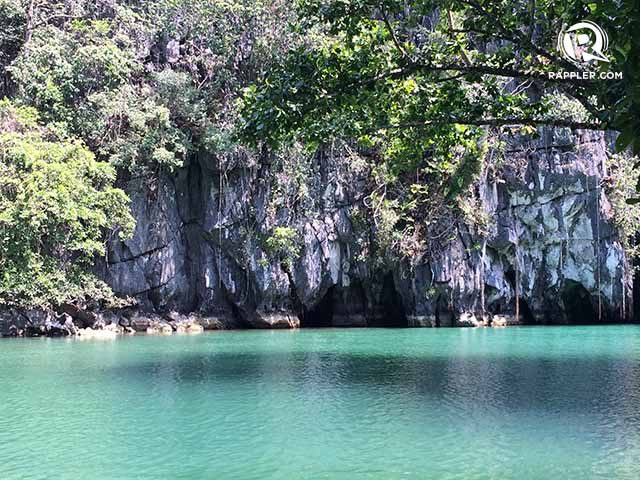SUMMARY
This is AI generated summarization, which may have errors. For context, always refer to the full article.

PUERTO PRINCESA, Philippines – The Underground River, together with 4 other Palawan protected sites, are the subject of debate in the proposed bill amending the law on the protected areas system of the Philippines.
The proposed bill or the Expanded National Integrated Protected Areas System (E-NIPAS), aims to strengthen Republic Act No. 7586 or NIPAS Act, which provided the legal framework of creation and management of protected areas in the country.
Protected areas, according to the law, are “identified portions of land and water set aside by reason of their unique physical and biological significance, managed to enhance biological diversity and protected against destructive human exploitation.”
According to Senator Loren Legarda, one of the authors of the bill, the proposed measure seeks to enhance conservation efforts in the protected sites and ensure the sustainable use of our natural resources and cultural diversity.
Department of Environment and Natural Resources (DENR) data show that when the NIPAS Act was enforced 1992, the country had 209 identified sites. As of December 2014, 177 protected areas have appointed or organized their respective management boards, a requirement under the law. However, only 98 sites are proclaimed under the NIPAS.
The proposed bill also creates “buffer zones” in protected areas, and bans mining and all forms of “extractive activities” within these site. The E-NIPAS Bill also imposes stiffer penalties on violators, including imprisonment.
The “counterpart” bill in the House of Representatives, however, seeks to repeal the NIPAS Act. The House version does not include 5 of Palawan’s protected areas: the El Nido Managed Resources Protected Areas, Malampaya Sound, Mt Mantalingahan, Puerto Princesa Subterranean River National Park, and Rasa Island Wildlife Sanctuary.
The Palawan provincial government is opposed to the Senate version of the bill. In the letters submitted to the House Committee on Natural Resources and the Office of Senator Loren Legarda, the Palawan Council for Sustainable Development (PCSD) said, “(T)the people of Palawan and its leaders are in unison in our appeal that Palawan Conservation and Protected Areas BE SEPARATED from the Omnibus Bill and that SPECIFIC LAW intended SOLELY for Palawan be promulgated.” [emphasis theirs]
Palawan governor and PCSD chairperson Jose Alvarez said in the letter that the existing Palawan Strategic Environmental Plan (SEP) Law is enough to provide protection in these specific 5 sites.
They said that rather than inclusion in the proposed E-NIPAS Act, Palawan needs a specific bill to strengthen its existing SEP law, and to have “commensurate budget allocation from the national government which they can cascade to every Palaweño that are the rightful stewards of Palawan’s natural endowments.”
Republic Act No. 7611 or the Palawan SEP Law is a statute that takes into account into administration and development, the unique characteristics of Palawan, which is often tagged as the Philippines’ last frontier. Palawan is the only province in the country with its own council for sustainable development.
The Palawan Network of Non-government Organzations Inc.(PNNI) contradicts the PCSD position.
In a letter to the members of the PCSD in October, PNNI Executive Director Robert Chan questioned the move to exclude the 5 protected areas from the proposed bill.
Ryan Maminta, Sangguniang Bayan member of the municipality of Narra, told Rappler that Narra, where Rasa Island Wildlife Sanctuary is located, opposes the provincial government’s position. Rasa Island Wildlife Sanctuary in Brgy. Panacan, Narra was declared a protected area in 2006. More than 100 species of birds, including the endemic Philippine cockatoo (Cacatua haematuropygia), live on the island.
He said he delivered a privilege speech on the issue a few weeks ago, which then led to a municipal resolution to signify their opposition.
“Pinadala na siya sa Kongreso. Kasi nung una nag-support kami sa Senate bill ni Loren at madali siyang naka-ano sa senado….Doon sa version ng House hindi kasama [ang Rasa Island] so, nakakalungkot,” Maminta said.
(We have sent our resolution to Congress. At first, we have supported Senator Loren Legarda’s bill….In the House version, Rasa Island was excluded, which makes us sad.)
However, in an interview, PCSD Executive Director Nelson Devanadera said that the Palawan government and the NGOs in the province have one common goal – to protect the environment.
“‘(Y)ung 5, ini-exclude namin [sa E-NIPAS bill] pero hindi ibig sabihin na hindi kami gagawa ng batas. We will have a seperate bill individually,” Devanadera said.
(We’re excluding the 5 sites from the E-NIPAS Bill but it doesn’t mean that we won’t make laws. We will have a separate bill for each of the protected area)
The Senate bill had been passed on third and final reading. The House Committee on Natural Resources had an executive meeting on Wednesday, November 11, 2015, but the agenda did not specify whether the House bill was taken up that day. – Rappler.com
Add a comment
How does this make you feel?
There are no comments yet. Add your comment to start the conversation.